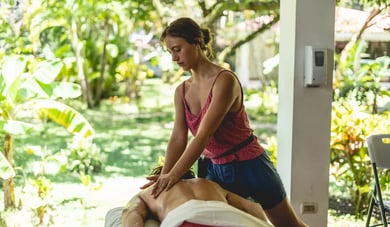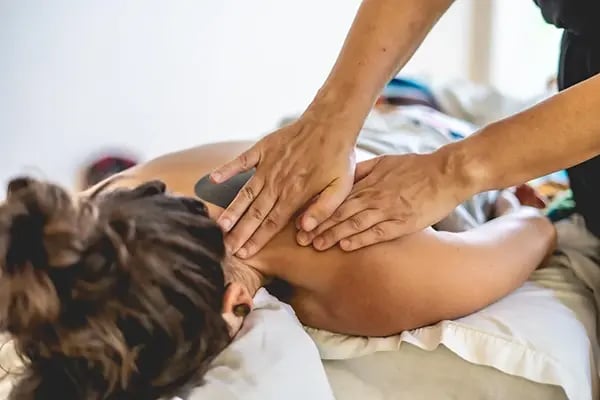

Learn how to give a relaxing and refreshing back massage with our easy step-by-step guide. Whether you're new to this or know a little bit, our guide will help you with everything, from creating a calm setting to learning advanced techniques. This way, you can give a soothing massage that helps get rid of stress and makes the body feel better.
Setting the Scene for Relaxation
Creating the right atmosphere is key to a successful back massage. Begin by choosing a quiet and comfortable space where the recipient can fully relax. Dim the lights or use soft, ambient lighting to create a calm environment.
Play soothing music or nature sounds in the background to help the recipient unwind. Ensure the room temperature is comfortable and have soft towels or blankets ready to keep the person warm during the massage.
Essential Tools and Products for an Effective Massage
Having the right tools and products can make the massage better. Use a good massage oil or lotion to help your hands move smoothly over the skin. You can even use Coconut Oil or Olive Oil, which you might already have at home!
Essential oils like lavender or eucalyptus can make the massage smell nice and relaxing. Always mix these oils with another oil to avoid skin irritation because they are very strong and shouldn't be used alone.
You can use a massage table or a firm, comfy surface like a bed or floor mat. Pillows or cushions can help support the person's body and make sure they are comfortable during the massage.
Mastering Basic Massage Techniques
Compression
Start with gentle compressions along the back to introduce your touch and begin to warm up the muscles. Apply gentle pressure with your palms as if you're squeezing the water out of a sponge.
Compression is a basic massage technique that involves pressing down on the muscles to help them relax and improve blood flow. To perform compression, follow these steps:
1. Start by placing your hands on the person's back.
2. Use the palms of your hands to apply gentle pressure.
3. Press down slowly and hold the pressure for a few seconds.
4. Release the pressure gradually.
5. Move your hands to a different spot and repeat the process.
6. Make sure to cover the entire back, focusing on areas that feel tight.
7. Adjust the pressure based on the person's comfort level.
8. Continue this technique for a few minutes to help the muscles relax.
9. Finish by gently rubbing the back to soothe the muscles.
Gliding or Effleurage
Next, begin gentle gliding "effleurage" strokes to warm up the muscles. Use the palms of your hands to make long, sweeping motions along the back. Gradually increase the pressure as the muscles begin to relax.
Effleurage is a swedish massage technique that involves long, gliding strokes to warm up the muscles and promote relaxation. To perform effleurage effectively, follow these steps:
1. Begin with light, gentle strokes using the palms of your hands.
2. Glide your hands smoothly over the skin, moving towards the heart to aid circulation.
3. Gradually increase pressure to warm up the muscles.
4. Use broad, sweeping motions to cover larger areas.
5. Maintain a steady rhythm to ensure a soothing effect.
6. Finish with lighter strokes to calm the muscles and complete the massage.
Kneading or Petrissage
Incorporate petrissage techniques by kneading the muscles with your fingers and thumbs. This helps to release tension and improve circulation. Use circular motions and vary the pressure to target different muscle groups effectively.
Petrissage is a massage technique that involves kneading, rolling, and squeezing the muscles to release tension and improve circulation. To perform petrissage effectively, follow these steps:
1. Begin by warming up the muscles with gentle effleurage strokes.
2. Use your fingers, thumbs, and palms to grasp and lift the muscle tissue.
3. Apply a kneading motion, similar to kneading dough, to work the muscles.
4. Roll the muscle tissue between your fingers and thumbs to break up knots.
5. Use circular motions to target specific areas of tension.
6. Vary the pressure to suit the recipient's comfort level.
7. Move systematically across the back, ensuring all muscle groups are addressed.
8. Incorporate squeezing motions to further release tightness.
9. Finish with lighter strokes to soothe the muscles.
10. Always check in with the recipient to ensure the pressure is comfortable and adjust as needed.
Targeting Key Areas for Maximum Relief
Focus on areas that typically hold tension, such as the shoulders, upper back, and lower back. Use your thumbs to apply deeper pressure to knots and tight spots, but be mindful of the recipient's comfort level.
Incorporate gentle stretching and mobilization techniques to increase flexibility and relieve stiffness. Begin by gently guiding the recipient's limbs through a range of motion, such as slowly lifting and lowering their arms or gently rotating their shoulders. This helps to loosen tight muscles and improve joint mobility. You can also use passive stretching, where you carefully stretch the recipient's muscles without them actively engaging, to further enhance flexibility. Pay special attention to areas that are prone to stiffness, such as the neck, shoulders, and lower back. Throughout the process, ask the recipient for feedback to ensure you are addressing their specific needs and preferences. Encourage them to communicate any discomfort or areas that require more attention, allowing you to tailor the session to provide maximum relief and relaxation.
Post-Massage Care and Tips
After the massage, encourage the recipient to rest and hydrate. Drinking water helps to flush out toxins released during the massage and aids in muscle recovery.
Suggest some light stretching exercises to maintain the benefits of the massage. Advise the recipient to avoid strenuous activities immediately after the session to allow their body to fully relax and recover.
The Costa Rica School of Massage Therapy is the world’s premier study abroad program for massage therapy. We offer a 600 to 800 hour COMTA Accredited Massage Therapy course which satisfies the licensing requirements for massage therapy in most of the United States. Additionally, we offer continuing education for massage therapists.





